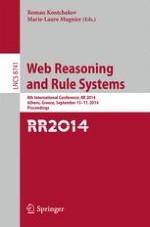This book constitutes the refereed proceedings of the 8th International Conference on Web Reasoning and Rule Systems, RR 2014, held in Athens, Greece in September 2014. The 9 full papers, 9 technical communications and 5 poster presentations presented together with 3 invited talks, 3 doctoral consortial papers were carefully reviewed and selected from 33 submissions. The conference covers a wide range of the following: semantic Web, rule and ontology languages, and related logics, reasoning, querying, searching and optimization, incompleteness, inconsistency and uncertainty, non-monotonic, common sense, and closed-world reasoning for the web, dynamic information, stream reasoning and complex event processing, decision making, planning, and intelligent agents, machine learning, knowledge extraction and information retrieval, data management, data integration and reasoning on the web of data, ontology-based data access, system descriptions, applications and experiences.


